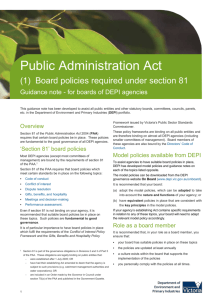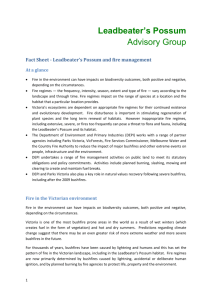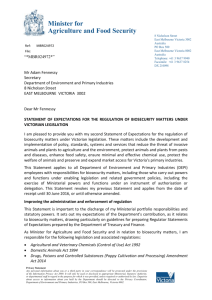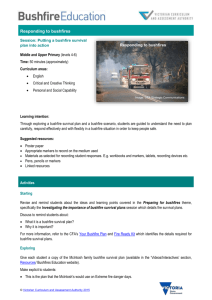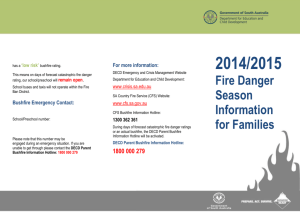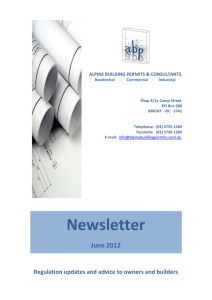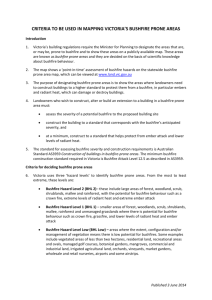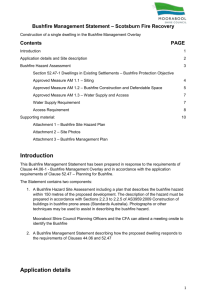Bushfire Science Strategy 2013-17
advertisement
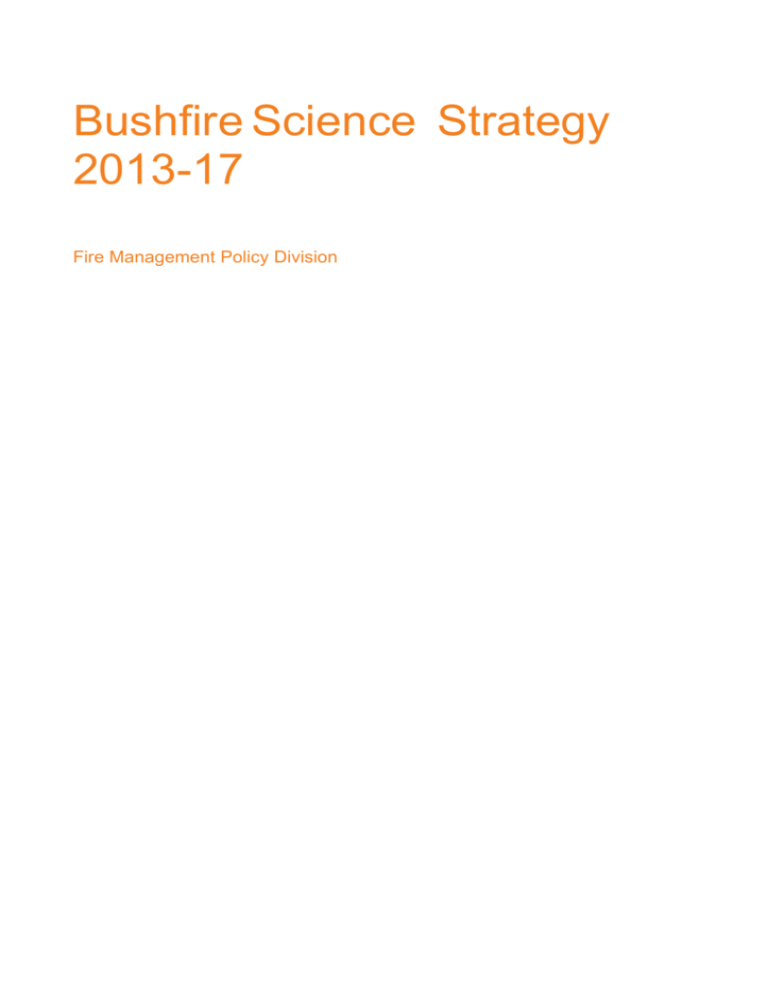
Bushfire Science Strategy 2013-17 Fire Management Policy Division Published by the Victorian Government Department of Environment and Primary Industries Melbourne, August 2013 © The State of Victoria Department of Environment and Primary Industries Melbourne 2013. This publication is copyright. No part may be reproduced by any process except in accordance with theprovisions of the Copyright Act 1968. Authorised by the Victorian Government, 8 Nicholson Street, East Melbourne. Print managed by Finsbury Green. Printed on recycled paper. ISBN 978-1-74287-900-0 (print) 978-1-74287-901-7 (pdf) For more information contact the DEPI Customer Service Centre 136 186 Disclaimer This publication may be of assistance to you but the State of Victoria and its employees do not guarantee that the publication is without flaw of any kind or is wholly appropriate for your particular purposes and therefore disclaims all liability for any error, loss or other consequence which may arise from you relying on any information in this publication. Accessibility If you would like to receive this publication in an accessible format, such as large print or audio, please telephone 136 186, or email customer.service@depi.vic.gov.au Deaf, hearing impaired or speech impaired? Call us via the National Relay Service on 133 677 or visit www.relayservice.com.au This document is also available in PDF format on the internet at www.depi.vic.gov.au Contents Introduction 2 Bushfire Policy and Science 3 Policy & Science Science 3 5 The Bushfire Science Framework 6 Strategy 1: Policy Driven Investment Strategy 2: Portfolio Structure and Responsiveness 6 7 Strategy 3: Knowledge Translation 10 References 13 Bushfire Science Strategy 2013-17 1 Introduction The management of bushfire in the Victorian landscape poses complex challenges that the Victorian Government and communities should understand and assess when choosing policy responses and management actions. Total losses from major bushfires in Victoria since 2002 include 176 lives and more than 2000 homes- exceeding 8 billion dollars in direct social, economic and environmental costs. The 2009 Victorian Bushfires Royal Commission (VBRC) highlighted this management complexity for bushfire. Through Recommendations 58 and 59 the VBRC clearly indicated a requirement to understand the bushfire-related risks to communities, essential and community infrastructure and services, industries and the environment. Assessing the level and tolerability of these risks, current and future priorities, strategies and actions, requires a rigorous and reliable framework for making decisions based on relevant knowledge. The VBRC exhorted government to “rebuild the capacity it once had as a leader in this field” (VBRC 2010: 19). The significant investment in bushfire preparedness and response that the Department of Environment and Primary Industries (DEPI) manages should be supported by a systematic and ongoing investment in developing scientific evidence. Through this investment DEPI can understand, analyse and evaluate the cause and effect relationships between various strategic and operational policy interventions and outcomes. This in turn enables DEPI to develop and implement programs with sufficient evidentiary basis to make sustained change. DEPI is a science-dependant organisation: good science provides good evidence, which in turn informs good policy. In recent years investments by DEPI in science were established by a range of strategies. They comprised a mix of ongoing investment and agreements with research institutes, and opportunistic investments arising through annual budget allocations and options linked to grant and initiative funding that in turn offer opportunities for leverage. To support this significant effort, a more comprehensive and explicit direction for current and future investment – where science quality, relevance and sharing are aligned – is needed. This bushfire science strategy (the Strategy) document describes the drivers for DEPI bushfire science investment, and then outlines strategies to ensure future investment is directed at meeting a vision of world class scientific evidence that meets bushfire management policy and operations needs on public land. The Strategy describes policy-driven investment-management, science portfolio structure and responsiveness to emerging needs, and knowledge translation, or sharing. This document sets out strategic directions in DEPI’s approach to bushfire science management. Its purpose is to ensure that DEPI’s science investment delivers evidence that informs strategic policy and operational decisions. It will increase the quality and relevance of the science program and help DEPI to leverage benefit from science that other parties fund. It will support DEPI’s aspiration to inform its decisions with science that is world class. The strategy supports DEPI in reducing bushfire-related risks, including the important element of fuel management. It also considers collaborative or multi-outcome science, and inter-agency or institutional programs. It takes into account partnerships, agreements and programs with the University of Melbourne, Department of Forests and Ecosystem Sciences (DFES), and other bushfire and land management research institutions including Cooperative Research Centres (CRCs). Bushfire Science Vision World class scientific evidence is developed that meets policy and operational needs for bushfire management on public land. Bushfire Science Strategy 2013-17 2 Bushfire Policy and Science Policy & Science Policy is a statement of intent, or commitment to a course of action, that government and its agencies adopt, pursue or direct as a principle or rule to guide decisions and actions. Government may express policy in such forms as legislation, statutory instruments, policy statements (both written and as oral undertakings on the public record such as parliamentary speeches), and government directives (such as the adoption of the VBRC recommendations). A key example of bushfire management policy is the Code of Practice for Bushfire Management on Public Land 2012 (the Code) which establishes objectives for bushfire management of public land and articulates a risk analysis framework based on the Australian/New Zealand Standard for risk management ISO 31000 (ISO 31000 Risk Framework). It directs that DEPI undertake all bushfire management within this ISO 31000 Risk Framework, where risk is ‘the impact of uncertainty on objectives’, and will be identified, analysed and evaluated, and risk treatments identified. For DEPI bushfire management risk exists both in the context of delivering strategic policy objectives that guide strategic and “big picture” decision making, and in an operational policy context through effective management of practical operations such as fuel management. Knowledge gaps or deficiencies can significantly impair effective policy development and/or delivery and increase risk exposure. Science is used within a risk management framework to guide strategies and actions. The use of supporting knowledge in strategies and determining actions and an adaptive management framework also promote continuous improvement in planning and management. Science investment guided by an informed understanding of current and future policy issues is a significant tool in mitigating poor policy outcomes. This investment provides evidence to support risk based management decision making frameworks critical in addressing any risk to DEPI policy objectives. This evidence needs to: Identify potential policy conflict that may be a risk to achieving policy objectives. For instance between minimising impact from bushfire through planned burning and maintaining natural systems to deliver services such as water quality. Support the analysis and evaluation of those policy risks by measuring and assessing the impact of those risks. Following the example at point one - through research evidence about the effect of repeated long-term burning on ecosystems. Inform the development of risk treatment options to mitigate those risks. An example is the development of fire protection zones. In a bushfire management context this allows us to better describe current and expected changes in bushfire risk when different policy directions are followed and as the policy environment evolves, and to select the most appropriate policies and implementation strategies based on an understanding of the respective costs and benefits. These costs and benefits are typically measured across a range of policy areas, including water, carbon, biodiversity (including threatened species and old growth), and/or air quality. Investment in science and research will provide the most benefit to DEPI’s bushfire management objectives if it is developed around a framework that aligns the program with DEPI’s policy environment. In this document Strategy 1- “Policy Driven Investment” describes actions to identify bushfire management policy and potential conflict, assigns them a risk rating, and identifies science that may contribute to treatment options and risk mitigation. Bushfire Science Strategy 2013-17 3 Strategic policy Strategic policy includes high level instructions from the elected government, and corresponding broad statements of objectives. Strategic policies’ for DEPI bushfire management include: The Government’s response to the recommendations of the VBRC. The response included a review of the Code of Practice for Fire Management on Public Land (2009), and committed to monitoring and research into the impact of bushfire management. The response also specified that fuel management activities would be increased to a rolling annual target of 5% of the public land estate. These instructions constitute a strong direction that DEPI learn from bushfire management actions, and recognise that these activities pose a significant source of policy risk. Environmental Partnerships (DEPI 2013), which has identified eight priorities to help strengthen our environmental partnerships and achieve our vision of a healthy Victorian environment that supports our prosperity and well being. Priority 3 of Environmental Partnerships identifies actions to manage risks to our communities and landscape from bushfire and flood. These include: - Delivery of effective fuel management programs. - Implementation of a risk-based approach to the management of bushfire and flood. - Better integration and strengthening of emergency management. Operational policy Operational policy includes institutional standards and procedures for management action. It applies across the spectrum of bushfire management activity – prevention, preparedness, fuel management, response and recovery, encapsulates directions for the conduct of bushfire management operations within DEPI based on the best available evidence. More practically, bushfire management operations, as activities that “deliver” strategic policy, carry risks – both policybased through their impact on delivery, and human-based in terms of the physical impact of the activity. The risks associated with operational activity are significant – from smoke generation and local erosion to the loss of human life – and is firmly entrenched as a factor in policy risk management. Bushfire Science Strategy 2013-17 4 Science “Science” in an adaptive management context is a cumulative process of discovery, where knowledge is sought through collecting empirical and measurable evidence, experimenting and formulating explanation and/or theoretical enquiry to test of our view of how part of the environment in which we live and work is subject to change, and to grow knowledge around this. Driving the requirements of a DEPI bushfire science program is the need to inform the achievement of DEPI’s policy objectives, and how these might impact on broader government and community objectives. Critical knowledge is required to support DEPI to achieve these objectives and reduce risk of failure. DEPI needs: Efficiency in procurement, administration and quality contract management with clear assignment of roles and responsibilities to support accountabilities. Value for money from science investment through effective management of the science program – including a model where researchers, research users, and other partners, clearly understand, are involved and have ownership of the purpose for the investment. The intent and contribution of the science program to be clearly communicated to government and the community. Stakeholders must be able to see that the science meets needs and supports DEPI to make better decisions and deliver better outcomes. Investment priorities to be clearly identified so that DEPI can collaborate on and leverage external opportunities and initiatives. The knowledge developed is communicated appropriately- clear links exist between knowledge and decisionmaking, and efficiency in using and valuing knowledge. This includes sharing, reviewing, incorporating and seeking new knowledge. A structured and strategic approach to capitalising on science investment so that opportunities can be maximised and suitable science projects can be appropriately targeted and supported. Integration of any science program with ongoing or future policy and strategic directions and/or programs, including monitoring programs. Science that itself meets rigorous scientific standards. Strategically creating new knowledge, and innovating through both applied and fundamental science (including some that is more pure and less certain of producing a particular benefit), will enable Victoria to work at the forefront of bushfire management. In this document Strategy 1-“Policy Driven Investment” describes program management and review actions. Bushfire Science Strategy 2013-17 5 The Bushfire Science Framework DEPI’s Bushfire Science Strategy focuses on three strategy areas: Policy driven investment management. Portfolio structure and flexibility. Knowledge translation. Each strategy area delivers outcomes for a more effective and efficient, policy driven, well managed, and useful bushfire research program. Strategy 1: Policy Driven Investment Overview DEPI’s operating environment is dynamic, so DEPI must stay aware of changes and proactively adapt its management of, and investment in, science. This ensures that the bushfire research portfolio remains topical, relevant and responsive to Victorian Government and community needs. DEPI ensures its investment in science is targeted at increasing DEPI’s capability to manage risks while implementing multiple policy directions. The experience of recent years has highlighted the need for DEPI’s approach to bushfire policy development, investment and practice to become more systematic, explicit and risk-based. Though the existing research program has delivered in terms of quality and applicability, it can be improved through a more systematic approach to assessing the policy, practice and risks related to the knowledge gaps that impact on DEPI achieving its bushfire management and fire ecology objectives. Being able to clearly articulate the existing bushfire research program (see Strategy 2 - “Portfolio Structure and Responsiveness”), what it delivers, and where the priority knowledge gaps occur, enables more effective sharing and feedback on the program, and the development or refinement of projects to target knowledge gaps. This allows DEPI to respond quickly and consistently in answering questions about resource requirements, in accessing external, collaborative or partnership opportunities, or in leveraging off existing programs. Fundamental to building this program is the need to ensure that the program remains relevant and responsive. Key questions for current policy drivers include: What are our policy objectives, and are the policy implementation questions well articulated? How does this science contribute to assisting the more efficient and effective achievement of objectives? Will science investment address DEPI policy needs in a timely manner? Does it complement existing projects and/or impact other policy areas? How is this impact weighted/valued comparatively? Are the knowledge gaps of a high enough priority to change our approach (whether policy, operational or both)? How do we measure effectiveness and value for money? Critically questioning the program provides a mechanism for assessing success, establishing an ongoing process, and ensuring that the science is adapting to changing needs. Monitoring and measuring the program’s performance supports observers and participants to maintain confidence in the program. An important step towards delivering this rigour is a dynamic or actively managed register of policy issues that identifies how knowledge gaps, or deficiencies, impact the implementation of DEPI objectives for bushfire management on public land. In particular it will inform science investment-decisions so that they are strongly accountable to the policy basis of DEPI’s work, and responsive to change. Bushfire Science Strategy 2013-17 6 Outcomes DEPI will better understand how knowledge gaps or deficiencies impact the implementation of DEPI policy objectives for bushfire management on public land. The impacts include collateral effects on government being able to deliver other policies. Investment value will be realised through the effective contract management of a portfolio that is topical, relevant and responsive to the needs of the Victorian Government and the community. Actions 1. Develop a rigorous framework for identifying and assessing policy risks associated with knowledge gaps, assigning them a priority, and adapting the active register (see Action 2 below) to reflect the priority knowledge gaps. 2. Develop an active register of future research projects that sets a direction for DEPI bushfire science investment, and a clear picture of intent, so DEPI can seek opportunities to target specific DEPI requirements more effectively. 3. Articulate mechanisms for periodically reviewing the program for efficacy and adaptability, to help DEPI recognise, predict, and respond to future bushfire management policy needs. This includes key performance indicators to transparently measure and report how the investment in science is contributing to policy development, the achievement of outcomes, and is delivering value for money. 4. Develop processes to ensure science contracts are effectively managed to deliver investment value, via service providers, to meet DEPI needs and conditions. Strategy 2: Portfolio Structure and Responsiveness Overview To support science management and communication, DEPI requires a transparent, flexible, and easily understood science framework that clearly articulates areas of research activity within both a scientific and policy relevant framework. This enables portfolio project consideration and adaptation across the breadth of DEPI interests. DEPI has identified categories for objective comparison for bushfire management. These can be allocated a level of significance, and used to transparently prioritise and plan strategies and actions to achieve the primary objectives of the Code. The “PIPE$S Framework” includes the categories of people, infrastructure, public administration, environment, economy and social setting, and allows for the introduction of further categories in the future. This is a key component of ensuring the science investment program is effectively directed by policy needs and can be communicated in a way that is relevant and consistent with the wider DEPI management environment Combined with the systematic framework for science developed by the United Nations (UN Science Framework), which addresses a full suite of research forms across diverse branches of science, the PIPE$S Framework increases the potential for the science portfolio to assess priority under these broad classes. It also enables the assessment of interactions’ between different science investment programs in the face of uncertainty about value and effects. An adaptation of the PIPE$S Framework and the UN Science Framework, allowing both rigor and flexibility to meet DEPI policy needs is included as Table 1. Bushfire Science Strategy 2013-17 7 Table 1: Bushfire Science Portfolio Structure Domains of Interest Branch of Science (UN Science Framework) Physical Study of non-living systems including water weather, geology, and climatology, which models or explains a particular aspect of the behaviour of nature. Social Understanding social phenomena, including attitudes, behaviour, culture and communication Forms of Research DEPI bushfire management PIPE$S category for objective comparison Applied* Experimental Development Pure Environment – ecosystem processes and functions that are influenced by physical factors such as geology and climate, and how this affects physical services they provide such as water and climate moderation. Using accumulated theories, knowledge, methods and techniques for a specific purpose – in this case a state-driven purpose. Usually directed at a specific practical/empirical aim or objective. Systematic work, drawing on existing knowledge gained through research and/or practical experience, which is directed to producing new materials, products or services, or to installing new processes, systems or services, or improving substantially those already produced or installed. Research aimed at increasing understanding of fundamental principles, which may have no direct or immediate benefit. Bushfire Hazard – the individual and combined effects of vegetation/fuel, weather/climate on occurrence, spread, severity, smoke effects and the likelihood of events with differing damage potential occurring. People - their physical safety and potential for property loss. Infra-structure – the value, exposure and vulnerability of essential and community assets. Public Administration – government’s ability to provide public administration, services and leadership. Economy – quantifying the financial value and impact of loss of assets, services and industries to the financial wellbeing of the community. Social setting – how a range of social, community and individual factors, separately and in combination, influence the emotional and physiological wellbeing of the community. Biological Study of life and living organisms. Environment – biological processes that influence the resilience and vulnerability of natural ecosystems, including how they respond to events and change; and how this effects biological services they provide such as biodiversity. * Please note the bulk of DEPI investment will continue as Applied Research. Adapted from the Frascati Manual (2002) and the Code of Practice for Bushfire Management on Public Land (2012). Bushfire Science Strategy 2013-17 8 Innovation, investment in higher risk. Categorising existing and proposed science projects within this Bushfire Science Portfolio Structure transparently demonstrates how each project responds to current DEPI policy directions or objectives (expressed as a PIPE$S Framework category). Including the policy knowledge gap risk potential (Strategy 1, Action 2), will enable DEPI to prioritise high risk knowledge gaps to determine future project investment directions. This leads to a structured priority list of science investment aspirations – as discussed in Strategy 1. An example of how the existing portfolio fits this framework in practice is included as Appendix 1, Table 3. Outcomes DEPI will invest in science projects that meet current bushfire management policy needs and adapts to those of the future – recognising that DEPI’s operating environment is dynamic. This bushfire science portfolio will be structured to align with an international best practice and the DEPI policy framework, and will strive to deliver world-class science. Actions 1. Develop and administer a catalogue of DEPI-resourced science projects, that is aligned with recognised best practice research guidelines and that meets the knowledge required for DEPI to address critical bushfire management policy and operational needs (see Tables 1 and 3). 2. Identify and contribute in-kind to external or leveraged projects that contribute science evidence that supports DEPI bushfire management and operational policy directions. 3. Develop a catalogue of research projects to which DEPI contributes in-kind. “If we knew what we were doing it wouldn’t be called research.” Einstein Bushfire Science Strategy 2013-17 9 Strategy 3: Knowledge Translation Overview Government and experienced researchers both recognise the importance of improved relationship building as a critical component of delivering better research and policy outcomes (Gibbons et. Al. 2008). Joint collaboration between policy makers, bushfire management operational practitioners, and researchers in the design, development and delivery of policy increases the efficiency and effectiveness of the service delivery (Ryan 2012). DEPI’s role is too efficiently and effectively meet government and community needs through good policy and operational delivery. To support this, it important that research institutions have a stronger understanding of the policy involvement and drivers for the use of their research. A joint approach will ensure: Generation and use of knowledge to reduce uncertainty in meeting policy objectives, and mitigate the risk of policy failure. Promotion of better understanding of the research program’s policy objectives and conflicts. Evidence-based management decision making in resolving policy conflicts. Establishing shared conceptual frameworks and understanding the assumptions that underpin them is required to bridge the gap between science evidence, and its use in management decision-making. This enables prediction and projection of the consequences to test different policy and strategy options as well assessment of their effectiveness and efficiency. Science needs to inform the decision-making support system. Knowledge, supporting management decision-making Knowledge is not an object; and it cannot simply be ‘transferred’ with the assumption that each person will understand it in the same way. The process of learning, where a person responds to information in a particular context and assigns it meaning and value is best described as translation. For DEPI, the sharing of context and ensuring translation of information into shared knowledge is critical to the delivery of reliable evidence to support decision-making. This knowledge translation needs to be supported by data management systems that store, share and retrieve information in a logical manner. These are an integral link between research creation and use, or re-use, however, information “objects”, such as reports, fact sheets or publications cannot be solely relied upon to deliver adequate and meaningful evidence. A strategy to translate information into shared knowledge must recognise the human processes in play. It needs to recognise context and interconnections. To address the complexity of human interaction and learning, this Strategy advocates a spectrum of knowledge translation mechanisms, from leveraging of inter-personal relationships to audience-specific communication. The principles of this approach include: Sharing context –when DEPI and researchers share the practical implications and critical drivers for the research, investment can become increasingly targeted and effective. The context of science investment enables its creators to directly improve the translation of research information into useful knowledge for DEPI. Utilising the available breadth of expertise- Purposefully identifying and encouraging DEPI expertise to engage with researchers’ enables science to become more practical. This supports the context sharing vital to knowledge translation and use. Audience relevance –words without context lack intrinsic meaning. Adapting language, delivery and contexts will enable complex or unfamiliar matters to be translated for individual audiences. This significantly enhances the opportunity to share knowledge effectively between individuals, increasing science uptake, use and support. Ongoing conversation – moving from passive actions such as websites, fact sheets, reports, and occasionally workshops, DEPI will complement these practices with strategies that promote a richer dialogue based on developing relationships and collaboration and establishing the conditions for changed learning practices. Translating science will become easier because the projects will become more accessible and communication, understanding, opportunity and individual engagement will improve. Through using these principles to build the knowledge translation strategy, more value will accrue both to researchers and DEPI. Research findings will be applied faster and more widely through policy responsiveness and adaptation of management decision-making, and funding opportunities will improve. DEPI will gain the benefit of the research findings being interpreted within DEPI’s own policy or operational context, which will stimulate a learning culture and build DEPI’s reputation as a world leader in bushfire management. Bushfire Science Strategy 2013-17 10 Outcomes That researchers, policy officers and bushfire management operational practitioners together translate knowledge producing robust evidence that effectively supports bushfire management decision making frameworks, enabling comparison and trade-off of values, mitigating policy risks, and constructing meaningful science. Actions Four actions are included below as Table 2. The actions are complementary: significant synergies are gained from combining them together. Bushfire Science Strategy 2013-17 11 Table 2: DEPI Actions for Science Knowledge Translation Action Objective Outputs Primary Participants Annual Fire Science seminar – presenting and discussing outcomes and aspirations for the future (appreciative enquiry); and developing communication options with the audiences involved. DEPI fire management – policy makers and practitioners. (high leverage, extensive or sustained gains) Developing research collaboration Relationship & partnership strengthening – DEPI and research providers engage in regular dialogue both in strengthening the research program, sharing knowledge and contributing to management decision-making models. Engagement & active involvement of research providers – DEPI staff and research providers create opportunities to discuss, debate, and define the research, to shape delivery and manage the program. Embedding Knowledge Interactive Knowledge Sharing Research institutions/individuals. Joint development, testing and use, and improvement of program. Complementary options: Forums. Workshops. Meaningful context for research – DEPI and research providers respond increasingly well to the nuances of policy context and management decision- making frameworks or models, as well as demonstrate that they understand and adapt to the various priorities for research development between and within organisations. They respond empathetically and collaboratively in maximising the program’s efficacy. Recruitment of district, regional & topical champions. Fire Division, L& F Areas/Districts. DEPI Fire Division/research providers collaboration sessions. DEPI, Universities of Melbourne, LaTrobe, Deakin and Monash. Building research capability & capacity – DEPI and research providers respond meaningfully and consider and adapt practices that translate knowledge. Individual research project presentations. Complementary options: Learning conversations. Professional development. Other education. Fire Science Strategy presentation/briefing. Complementary options: DEPI Fire management – policy makers and practitioners. Research provider institutions/individuals. Presentations. Project briefings. Contact mapping. Passive Information Quality products – DEPI and research providers summarise, on-line and/or in print, the reports for DEPI-sponsored research projects. They develop a suite of audience-specific “fact sheets’ to encapsulate and transfer findings to a mainstream audience. Audit DEPI fire research web page and the relevant part of Fireweb. Support information on external organisations’ websites. Publish consistent high-quality reports for projects. Develop project-based fact sheets in “plain English”. Complementary options: Website. Report Series. Fact Sheets. Email bulletins. Bushfire Science Strategy 2013-17 12 DEPI community. Community & stakeholder groups. Government. Research institutions/individuals. References Australian Government (2011) “Strategic Policy Toolkit”, http//:strategicpolicy.govspace.gov.au/what-is-strategic-policy/ Blair et.al. (2010a) “Understanding, Developing and sharing knowledge about fire in Victoria, Australia”, Fire and Adaptive Management Report No. 77, Department of Sustainability & Environment, Melbourne. Victoria Blair et. al. (2010b) “A case study of a “Strategic Conversation” about fire in Victoria, Australia”, Fire and Adaptive Management Report No. 79, Department of Sustainability & Environment, Melbourne. Victoria Campbell et. al. (2012) “Guiding Principles: facilitated learning, understanding and change through relationship, Fire and Adaptive Management Report No. 80, Department of Sustainability & Environment, Melbourne. Victoria Campbell et. al. (2010a) “Adaptive management of fire: The role of a learning network”, Fire and Adaptive Management Report No. 76, Department of Sustainability & Environment, Melbourne. Victoria Campbell et. al (2010b) “Developing a fire learning network: A case study of the first Year”, Fire and Adaptive Management Report No. 78, Department of Sustainability & Environment, Melbourne. Victoria Department of Sustainability & Environment (2013) “Environmental Partnerships”, Victorian Government. Department of Sustainability & Environment (2012) “Code of Practice for Bushfire Management on Public Land”, Victorian Government. Department of Sustainability & Environment (DEPI) “Corporate Plan 2012-15”, Victorian Government. Department of Sustainability & Environment (2011) “DEPI Fire Business Plan Summary 2011-12”, Victorian Government. Frascati Manual (2002) “The Proposed Standard Practice for Surveys of Research and Experimental Development, 6 Edition” United Nations. th Gibbons et.al (2008) “Some practical suggestions for improving engagement between researchers and policy-makers in natural resource management”, Fenner School of Environment and Society, Australian National University, Canberra. Standards Australia (2004) “Risk management- Principles and Guidelines, AS/NZS ISO 31000:2009”, Standards Australia, Sydney. 2009 Victorian Bushfires Royal Commission (2010) “Final Report; Summary”, Parliament of Victoria. “A child of five would understand this. Send someone to fetch a child of five.” Groucho Marx , Bushfire Science Strategy 2013-17 13

